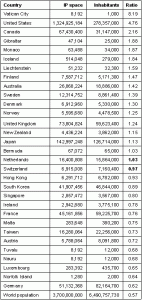The world is running out of IPv4 Internet addresses, which is why we should work on the deployment of IPv6. Or so the reasoning goes. The address space exhaustion is well documented and real, see also my earlier post.
 But how much of these addresses are really in use, and how do countries differ in that respect? Is there any chance we can recycle a lot of unused addresses? It would be interesting to see how much of the space allocated to a country is actually used.
But how much of these addresses are really in use, and how do countries differ in that respect? Is there any chance we can recycle a lot of unused addresses? It would be interesting to see how much of the space allocated to a country is actually used.
I got some very interesting data from Akamai, whose content distribution network delivers 10-20% of all web traffic. (They do a lot of the traffic of MySpace and Logitech, for example). Akamai kindly provided me with a list of the total number of unique IP addresses that they actually see in use, per country. By comparing this with the number of allocated IP addresses, we can get a feel for the efficiency with which these addresses are used. The table shows the address utilization for all countries with more than 10 million allocated IP addresses.
The worst performers outside of this group are typically very small and/or poor countries.
The best performer above 1 million allocated addresses is Turkey with 42% utilization. There are better performers but they are pretty small, which reduces the accuracy with which we know their data. The full data is visualized in the following heatmap.
One methodological note to make is that Akamai can only see IP addresses in use by real users. This excludes addresses that are used by machines such as routers, servers, and camera’s etcetera. A further assumption is that Akamai sees most of the active Internet users. Actually for all the relevant countries Akamai sees over half of active users. We’ll assume that this does not bias any specific country.
More than half the countries have better than 17% utilization. Well developed countries typically have higher utilization rates, with the exception of the United States (7.1%). The global average is 12,8% utilization.
So, are we running out of IPv4 addresses? Geoff Huston expects IPv4 addresses to be depleted at the RIR level around 2011. This is an extrapolation of current practices, which may or may not be optimal. Our analysis here shows that it is pretty hard to get higher than 30-40% utilization. At these utilization rates, there is in the end only 1 IP address for every 5-6 world inhabitants, even though the Internet can then grow to 3 times its current size. At today’s growth rates of active internet penetration (20% ?) our current address allocation model will be exhausted in around 6 years (around 2014). This is true even if the US starts selling off its surplus of IP addresses to the market.
For an interesting additional perspective on the relation between users and IP adresses, have a look at Comcast: the myth of static IP
Do a FREE course
Are you not sure if you are ready to start a full CCSK training yet? Then this course is perfect for you. It will give you a good idea of how worthwhile it is to go for the CCSK certification. You will also cover some of the basics that are required for the full course.
And the best thing? It’s for free! Click on the button below and start learning about CCSK v4.
2 Comments on “United States is world leader in IPv4 address waste”
Leave a Reply
You must be logged in to post a comment.

Anonymous
25 November 2008 at 23:01>Hmm..
Using akamai as a source isn’t really representative is it?
– it only accounts for stats of IP addresses of computers with on which people browse the web
– Not taking in account all the (web)servers in the world.
– Not taking in account all the workstations without a browser (or coproate PC’s with strict browsing policies
– Not taking in account that a lot of
Anonymous
30 December 2008 at 17:07>Exactly, this is a ridiculous article; I suggest you consider other factors and sources before making a final decision that the United States is wasting IP addresses.